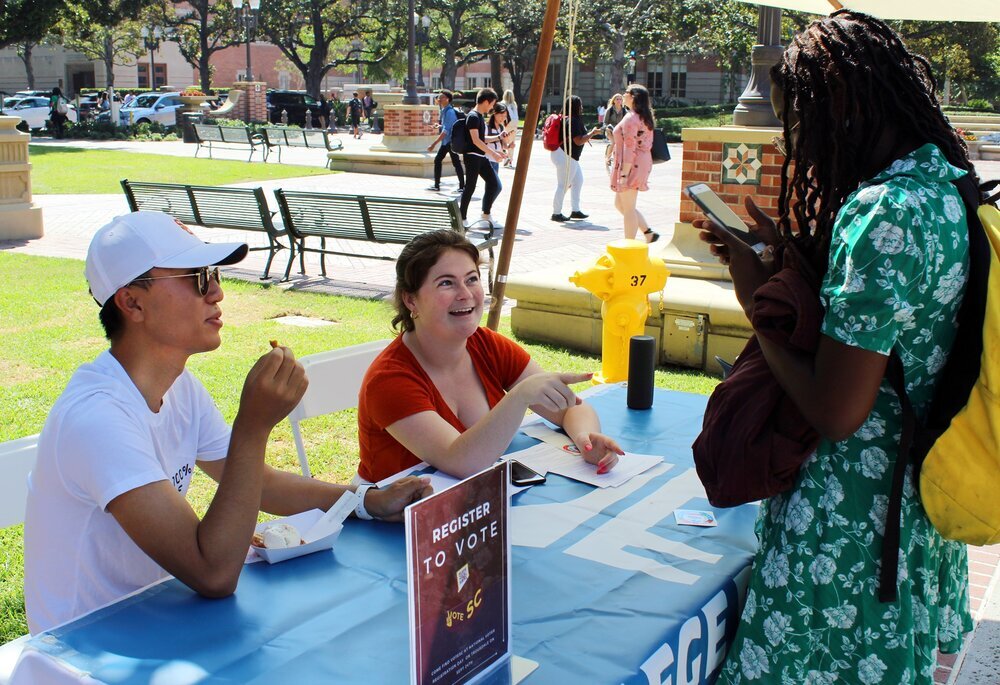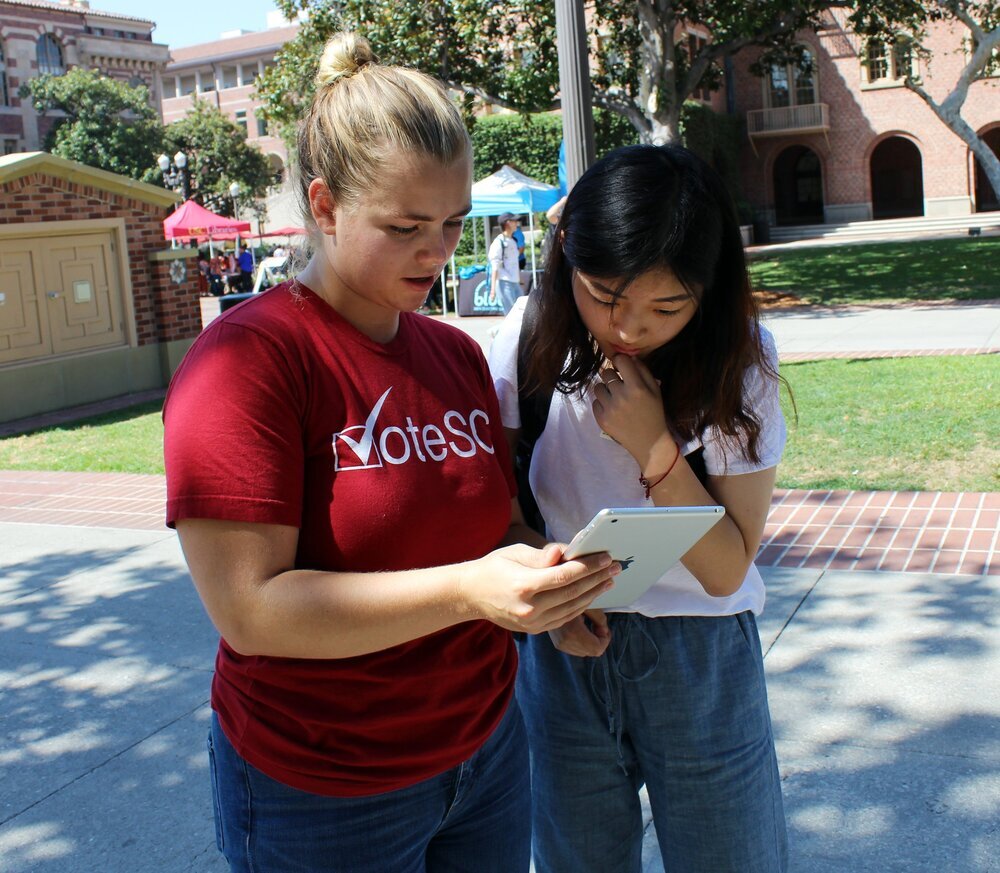University of Southern California
2018 Success Story
When the University of Southern California (USC) celebrated National Voter Registration Day back in 2017, student volunteers did some tabling, passed out t-shirts, and engaged around 100 people. Even though every voter registered is a success, students and staff at USC knew they were capable of so much more.
USC partnered with TurboVote in August 2018 in the hopes of reaching more students, streamlining voter engagement opportunities and, in particular, helping the university’s many out-of-state students cast their ballots more easily. In the end, they achieved much more than that. In just the few months between the start of the 2018 fall semester and the end of the year, the newly-formed VoteSC coalition generated more than 1,700 TurboVote signups.
We sat down with VoteSC co-presidents Elle Viotto and Briana Miles, VoteSC Senior Advisor Alec Vandenberg, and Meghan Ginley, Manager of the Jesse M. Unruh Institute of Politics which is housed in the USC Center for the Political Future, to learn more about how they did it. Was it easy? No. Was it worth it? Absolutely.
Streamlined and digital
Going into the fall of 2018, there was plenty of work to be done. Alec Vandenberg explained that, prior to partnering with TurboVote, “efforts were very fragmented and physical.” Meghan Ginley furthered, “We weren’t being strategic about how we were engaging our students, most of whom are from out of state.” Briana Miles, VoteSC co-president and an out-of-state student herself, commented that living outside of California made participating in elections “extremely difficult.”
Two developments helped turn this around. The first development was the formation of the VoteSC coalition, which streamlined and centralized voter engagement efforts on campus. VoteSC began as an initiative spearheaded by USC Undergraduate Student Government (USG), the USC Political Student Assembly (PSA), and the Center for the Political Future. Miles explained that all three organizations counted civic engagement as part of their missions and in 2018, they decided to pool their efforts. Looking to reach as many students as possible, VoteSC quickly began looking for other allies. They reached out and partnered with more than a dozen other student groups on campus, along with university offices like the Career Center.
The second development, of course, was USC’s new partnership with TurboVote. With TurboVote, VoteSC could point students and allies toward one link that provided all users with the resources they needed to vote, no matter where they were from or where they wanted to cast their ballots. Vandenberg remarked on how useful it was to have a “one-stop-shop for everything voting,” even for those who were already registered to vote.
Engaging the entire campus
Bringing together a cohort of offices and organizations meant that VoteSC could reach a much wider cross-section of the student population. They took care to leverage the relationships that USG had with different student organizations on campus in order to represent the diversity of USC students. It also helped that students themselves were deeply involved leaders in the coalition. As Elle Viotto explained, even “knowing that the dining halls get busy at a certain time” went a long way in reaching as many students as possible. Furthermore, for many students, hearing about civic participation from adults can “sound like a chore,” but they tend to be more receptive if it comes from a peer. “We think it’s important to have that visibility of people that [students] can relate to,” Viotto concluded.
These efforts alone demonstrate VoteSC’s commitment to engaging as many students as possible, but they went a step further and found an unexpected ally: international students. Nearly a quarter of USC students are international, a figure much higher than most campuses. Many of them were U.S. expats who did not know they were eligible to vote, and learned that they could from VoteSC. Many others were ineligible to vote, but remained highly interested in American politics and wanted to get involved; and VoteSC was eager to include their voices. As a result, a number of international students became “champions” of voter engagement. They helped table, canvas, and register eligible students to vote, even though they couldn’t themselves. It was perhaps even more powerful for American students to hear about how important elections were from those who couldn’t participate themselves, but felt compelled to encourage others.
“The goal for VoteSC has always been to institutionalize voter engagement on this campus.”
— MEGHAN GINLEY,
Manager of the Jesse M. Unruh Institute of Politics
Far and wide but grounded
Though VoteSC is effectively an umbrella organization that taps into numerous channels and partnerships from across campus to promote voter engagement, strong branding and centralized leadership grounds its efforts. The initiative’s name, logo, and newly-updated website (voteusc.com) are excellently designed and tap into campus pride in a way that “inspires more confidence” in VoteSC’s efforts, according to Vandenberg. Strong branding helps make it clear that VoteSC is a comprehensive initiative that’s here to stay, not just a one-off campaign that pops up every other November and then largely fades away the rest of the year. Furthermore, in the coalition’s early days, VoteSC members spent a lot of time peppering social media groups, email lists, and other channels with messages promoting TurboVote. But as VoteSC gained more allies and name recognition, Vandenberg explained that “it shifted from us as individuals promoting a link to an organization promoting a cause.” Viotto remarked that once groups on campus became coalition partners, it became easier to rely on them to build on the foundation of VoteSC’s overarching mission and messaging to educate their own members.
Roadblocks and rallies
“The goal for VoteSC has always been to institutionalize voter engagement on this campus,” Ginley reflected. But the path to institutionalization wasn’t always a smooth one. Viotto recalled that a number of VoteSC’s early efforts were “stonewalled,” including attempts to send campus-wide emails and integrate VoteSC into a student portal. Cold emails to departments asking them to help out with TurboVote promotion didn’t always work.
To overcome these obstacles, persistence was key. Ginley said, “I just started walking around making contacts and asking questions.” This approach paid off. One conversation with someone at a lunch completely unrelated to voter engagement established a relationship that became instrumental when VoteSC sought to integrate TurboVote into their new student orientation app.
In its infancy, the VoteSC team was happy to make connections wherever they could. But as time went on, VoteSC was able to leverage its track record and growing campus-wide recognition to open doors it otherwise couldn’t have. With this new legitimacy, Viotto said, “it [became] easier to get our foot in the door.” On top of that, publicity about VoteSC prompted some groups to actively reach out to get involved, including a group of graduate students from the USC School of Social Work.
Expectations vs. reality
VoteSC went from scrambling for any ally they could find to having allies approach them. On top of that, in honor of National Voter Registration Day 2019, VoteSC arranged for USC’s new president Carol Folt to register to vote as a California resident, give a speech, and sign a memorandum of understanding outlining the university’s commitment to voter engagement. Receiving that public commitment from the highest authority in the university was a testament to how far USC had come in institutionalizing civic participation.
How did their results compare to what the VoteSC team expected at the start? Viotto recalled, “at the outset...I said it would be an optimistic goal to do 500 signups.” Miles furthered that at USC, “getting students to engage with politics has always been tough.” Additionally, the coalition, which began its efforts in earnest in 2018, faced the “double battle” of convincing people that midterm elections mattered. Even for VoteSC’s stellar team, getting to nearly 2,000 signups was “beyond the realm of expectation.” In terms of how those signups translated into ballots cast, USC’s 2018 NSLVE report shows a voting rate of 45.4 percent, which is an increase of nearly 30 percentage points compared to 2014. How’s that for expectations vs. reality?





